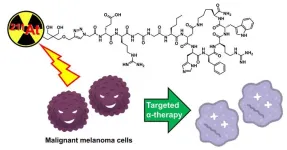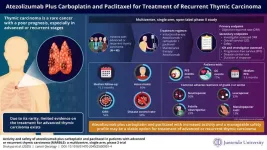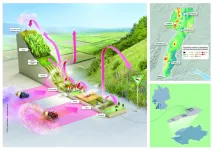(Press-News.org) Researchers have conducted the first national survey on public awareness and perceptions of food, health, and Food is Medicine programs. A team at the Food is Medicine Institute at the Gerald J. and Dorothy R. Friedman School of Nutrition Science and Policy at Tufts University found that nearly 90 percent of Americans surveyed agreed that eating healthy foods is important for preventing conditions like obesity, high blood pressure, and type-2 diabetes.
The results, published March 12 in the journal Health Affairs, revealed that while under 30% have heard of the Food is Medicine movement, more than half would try a produce prescription, medically tailored grocery, or medically tailored meal program, if offered through their health care providers. Among those with food and nutrition insecurity, interest in participating rises to nearly 70%.
Additionally, more than two-thirds of those surveyed felt that government programs like Medicare and Medicaid should cover Food is Medicine initiatives, while about half of the participants said that private insurance should also pay. The 24-question survey was completed from February through April 2023 by over 3,000 adults, representing U.S. demographics across sex, race, insurance coverage, household income, education, and health status.
“This study affirms that the public understands the importance of food in their health, but they don't always have means to access the food they want," said first author Ronit Ridberg, a research assistant professor at the Friedman School. "We were struck by the disconnect we found in clinical settings. Only a quarter of respondents reported that their primary care provider had asked if they had enough food to eat, and fewer than half had conversations about diet during their clinical encounters."
The common experiences reflected in the surveys are likely due to health care providers not having received nutrition education during their training as well as being burdened for time to get through many topics in a single appointment, said Ridberg. In her conversations with doctors and nurses, she has heard that they can feel uncomfortable asking about food and nutrition insecurity and often don’t know the right resources to give patients.
Based on the survey, about half of Americans would be more likely to make positive dietary changes if they had regular conversations about their habits with care providers. Over 80% of respondents agreed they would take steps to eat healthier if they knew it would help them feel better, treat a health condition, or reduce their risk for future disease. But many people are facing financial barriers, with 83% of those surveyed reporting the cost of healthy food as the most frequent barrier to its consumption, and over 50% believing that health care should help reimburse or provide for some healthy food.
After cost, the most common reported hurdles to healthy eating included family traditions that center around unhealthy foods (79%), a lack of healthy options where people go shopping (57%), stores or food pantries that sell healthy foods are too far away (56%), and not knowing what foods are considered healthy (48%).
“There’s a misconception that many people don’t want to eat nourishing foods, or that they prefer unhealthy products—but our new results highlight that most Americans want to eat better but face specific barriers and challenges,” said Dariush Mozaffarian, senior author on the paper and director of the Food is Medicine Institute at the Friedman School. “Our research shows that there is demand for food-based therapies as part of health care, providing valuable information for state and federal policymakers to build momentum toward more holistic, cost-effective care.”
The researchers are participating in the 2nd Annual Food is Medicine Advocacy Day on Capitol Hill to talk with House and Senate leaders about strengthening the infrastructure for Food is Medicine programs. This could include, for example, increasing nutrition-related training for doctors, supporting cutting-edge research on Food is Medicine at the National Institutes of Health, and expanding programs and coverage through Medicare, Medicaid, and the U.S. Department of Veterans Affairs.
Research reported in this article was supported by the Kaiser Permanente East Bay Community Fund and included authors from Harvard University, in addition to authors from the Friedman School. Complete information on authors, methodology, limitations and conflicts of interest is available in the published paper.
The content is solely the responsibility of the authors and does not necessarily represent the official views of the funders.
END
First national perception survey of Food is Medicine programs shows strong public support
Researchers find majority of Americans surveyed, especially those affected by food and nutrition insecurity, would be interested in food-based nutrition interventions
2025-03-12
ELSE PRESS RELEASES FROM THIS DATE:
UNCG professor investigates how symbiotic groups can behave like single organisms with $600,000 in Templeton Foundation funding
2025-03-12
"UNCG philosopher of biology Dr. Derek Skillings is the lead investigator on a new, three-year, $600,000 grant from the John Templeton Foundation for a study of the emergence and evolution of goal-directed behavior in collective entities.
“A holobiont is a term for a host organism and all of the things that live inside of it and on it,” says Skillings, who is an assistant professor of philosophy at UNCG with adjunct positions in biology and geography, environment, and sustainability.
Examples of collective entities include simple biofilms and massive coral reefs.
“We used to think these weird things like corals, ...
Targeted alpha therapy: a breakthrough in treating refractory skin cancer
2025-03-12
Metastatic melanoma, also known as stage IV melanoma, is a type of skin cancer that spreads to other parts of the body. It is one of the most aggressive forms of skin cancer, with current therapies—including immunotherapy and targeted drugs—showing limited effectiveness. Radiotherapy is an emerging treatment for melanoma, but conventional beta-emitting radionuclide therapies have limitations due to their low energy transfer and long-range radiation, which can cause unintended damage to healthy tissues.
To enhance the efficacy of radiotherapy, a research team from Japan, led by Assistant Professor Hiroyuki Suzuki ...
Transforming thymic carcinoma treatment with a dual approach
2025-03-12
Thymic epithelial tumors are a rare group of malignancies originating in the thymus gland, that includes thymoma and thymic carcinoma. Among these, thymic carcinoma is the more aggressive subtype, characterized by high invasiveness, metastatic potential, and poor prognosis. With an incidence of just 0.15 cases per 100,000 person-years, its rarity poses significant challenges for treatment development. While platinum-based chemotherapy remains the current standard of care, its efficacy is limited. Immune checkpoint inhibitors have shown promise in pretreated cases, but durable ...
Wrong on skin cares: keratinocytes, not fibroblasts, make collagen for healthy skin
2025-03-12
The skin consists of two primary layers. The epidermis, the outermost layer, is predominantly made up of keratinocytes, while the deeper dermis contains blood vessels, nerves, and structural proteins such as collagen, which give the skin its strength and texture. Traditionally, fibroblasts—specialized supporting cells within the dermis—have been believed to play a key role in producing collagen.
In humans, collagen is formed before and after birth. It has been believed that fibroblasts play an exclusive role in collagen production in the skin, and no keratinocytes contribute to collagen production. The statement “Collagen production in the human skin is achieved by fibroblasts” ...
Delhi air pollution worse than expected as water vapour skews figures
2025-03-12
New Delhi's air pollution is more severe than previously estimated with particles absorbing atmospheric water vapour leading to particulate matter levels across the city being underestimated by up to 20%, a new study reveals.
Hygroscopic growth causes fine particulate matter (PM1) to swell, reducing sampling devices efficiency and leading to underestimation, with greatest underestimation in estimated concentrations happening during winter morning rush hours, when humidity is highest and pollution is most severe.
In contrast, research shows that the monsoon ...
First radio pulses traced to dead-star binary
2025-03-12
An international team of astronomers, including a Northwestern University astrophysicist, has traced a series of mysterious radio pulses to an unprecedented home.
Starting a decade ago, astronomers have detected a pulse of radio emission every two hours, coming from the direction of the Big Dipper. After combining observations from multiple telescopes, the team can now reveal the culprit: a binary system with a dead star.
According to the new study, a red dwarf and white dwarf are orbiting each other so tightly that their magnetic fields interact. Each time they bump together — which is every two hours — the interaction emits a long radio blast.
Although astronomers ...
New membrane discovery makes possible cleaner lithium extraction
2025-03-12
Researchers have developed a new process for sustainable lithium extraction, which could help to address the growing global demand for the metals used in electric vehicle batteries and renewable energy storage.
Current ways of getting lithium are bad for the environment and more sustainable approaches are hard to perform on a large scale, but scientists have developed new membranes to pull lithium directly out of salty lake water using electricity, leaving other metal ions behind.
Publishing their findings in Nature Water today (12 Mar), the international group of researchers from the UK, France, ...
Entwined dwarf stars reveal their location thanks to repeated radio bursts
2025-03-12
An international team of astronomers led by Dr Iris de Ruiter, now at the University of Sydney, has shown that a white dwarf and a red dwarf star orbiting each other every two hours are emitting radio pulses.
Thanks to follow-up observations using optical and x-ray telescopes, the researchers were able to determine the origin of these pulses with certainty. The findings explain the source of such radio emissions found across the Milky Way galaxy for the first time.
The results are published in Nature Astronomy.
In recent years, better analysis techniques have given researchers the ability ...
Landscape scale pesticide pollution detected in the Upper Rhine region, from agricultural lowlands to remote areas
2025-03-12
A recent study by the RPTU University Kaiserslautern-Landau shows extensive pesticide contamination in the landscape of the Upper Rhine Region. The research team led by Carsten Brühl shows for the first time that synthetic chemical pesticides from conventional agriculture do not remain on the cultivated areas, but spread from the lowlands to the Black Forest and the Palatinate Forest. The results show that the entire landscape is contaminated with pesticide mixtures, shedding new light on the potential environmental ...
Decoding nanomaterial phase transitions with tiny drums
2025-03-12
When water freezes into ice or boils into vapour, its properties change dramatically at specific temperatures. These so-called phase transitions are fundamental to understanding materials. But how do such transitions behave in nanomaterials? In Nature Communications, a team of scientists led by TU Delft (The Netherlands) presents new insights into the complex nature of phase transitions in magnetic nanomaterials. Their findings reveal the coupling between magnetic and mechanical properties, paving the way for ultra-sensitive sensors.
The scientists from TU Delft, together with colleagues from the University of Valencia and the National University of Singapore, studied ...
LAST 30 PRESS RELEASES:
Interaction of climate change and human activity and its impact on plant diversity in Qinghai-Tibet plateau
From addressing uncertainty to national strategy: an interpretation of Professor Lim Siong Guan’s views
Clinical trials on AI language model use in digestive healthcare
Scientists improve robotic visual–inertial trajectory localization accuracy using cross-modal interaction and selection techniques
Correlation between cancer cachexia and immune-related adverse events in HCC
Human adipose tissue: a new source for functional organoids
Metro lines double as freight highways during off-peak hours, Beijing study shows
Biomedical functions and applications of nanomaterials in tumor diagnosis and treatment: perspectives from ophthalmic oncology
3D imaging unveils how passivation improves perovskite solar cell performance
Enriching framework Al sites in 8-membered rings of Cu-SSZ-39 zeolite to enhance low-temperature ammonia selective catalytic reduction performance
AI-powered RNA drug development: a new frontier in therapeutics
Decoupling the HOR enhancement on PtRu: Dynamically matching interfacial water to reaction coordinates
Sulfur isn’t poisonous when it synergistically acts with phosphine in olefins hydroformylation
URI researchers uncover molecular mechanisms behind speciation in corals
Chitin based carbon aerogel offers a cleaner way to store thermal energy
Tracing hidden sources of nitrate pollution in rapidly changing rural urban landscapes
Viruses on plastic pollution may quietly accelerate the spread of antibiotic resistance
Three UH Rainbow Babies & Children’s faculty elected to prestigious American Pediatric Society
Tunnel resilience models unveiled to aid post-earthquake recovery
Satellite communication systems: the future of 5G/6G connectivity
Space computing power networks: a new frontier for satellite technologies
Experiments advance potential of protein that makes hydrogen sulfide as a therapeutic target for Alzheimer’s disease
Examining private equity’s role in fertility care
Current Molecular Pharmacology achieves a landmark: real-time CiteScore advances to 7.2
Skeletal muscle epigenetic clocks developed using postmortem tissue from an Asian population
Estimating unemployment rates with social media data
Climate policies can backfire by eroding “green” values, study finds
Too much screen time too soon? A*STAR study links infant screen exposure to brain changes and teen anxiety
Global psychiatry mourns Professor Dan Stein, visionary who transformed mental health science across Africa and beyond
KIST develops eco-friendly palladium recovery technology to safeguard resource security
[Press-News.org] First national perception survey of Food is Medicine programs shows strong public supportResearchers find majority of Americans surveyed, especially those affected by food and nutrition insecurity, would be interested in food-based nutrition interventions







